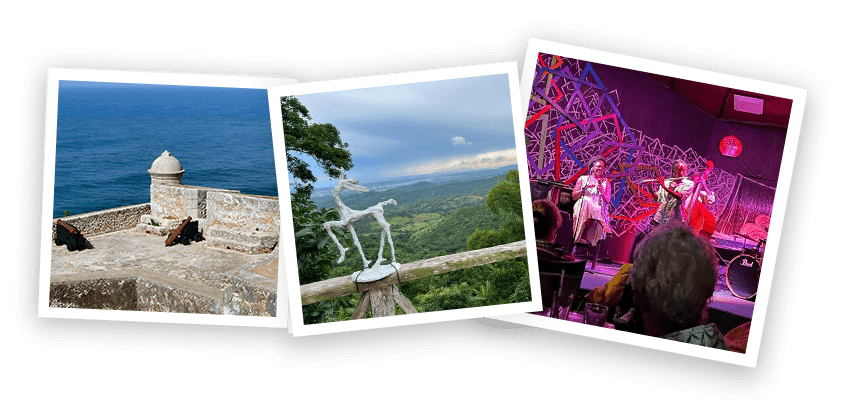
Eastern Cuba
Lesser Known Gems of Cuban Roots with Journey Leader: Chip Barclay
Santiago de Cuba - Baracoa - Guardalavaca - Holguin

May 24 - June 3, 2024
Day-by-day itinerary

Itinerary is subject to change.
SANTIAGO DE CUBA | Less visited by tourists, Santiago is the Cuba's second largest city, known for its stunning natural beauty and traditional dances, most notably son, from which salsa has been derived. A high number of residents of the city adhere to Afro-Cuban religions, most notably santería. The city hosts descendants of immigrants from the early 19th century from Haiti. Some aspects of the religious "vodú" heritage of the city can be traced back to this community.
Santiago de Cuba features several historic architectural styles, from Baroque to neoclassical. Many colonial buildings have huge windows and balconies, where people can enjoy views of the steep streets and wooded hills.
Arrival and transfer to bed and breakfast.
Walking tour around Parque Cespedes. Visit to Casa de Diego Velazquez, the oldest one in Cuba, built in 1522 as the official residence for the first governor of the Island. Walk up and down Calle Enramada the longest and most populous boulevard in Santiago, where the largest numbers of businesses, recreational and artistic centers are located. Visit to the Carnaval Museum. Santiago is home to the biggest and best summer carnivals, this museum is a treasure-house showcasing some of the best costumes, photographs, original music instruments and other memorabilia.
Visit to the City Historian Office to meet Omar Gonzalez for a talk about the history of Santiago de Cuba since its foundation until the present days. Sightseeing tour around Antonio Maceo Revolution Square. Visit to San Juan Hill memorial site.
Santa Ifigenia Cemetery is among the oldest ones in Cuba. Visit this main cemetery of the city where poets, musicians, historical figures and patriots are buried; including Jose Marti and Fidel Castro.
Moncada Garrison. The assault on the Moncada was an armed action carried out on July 26, 1953 by a group of young people led by lawyer Fidel Castro in order to overthrow the dictator Fulgencio Batista. It was a military failure that sparks the flame of the Revolution. Visit to artists’ studios, including the Aguilera Workshop for fine arts and design. It is an Open Studio that works towards the community.
The Alberto Lescay’s workshop. Lescay is an important sculptor and painter who was awarded in 2021 with the Cuban National Prize of Fine Arts. He presides over Caguayo Foundation for Monumental and Applied Arts. We will see many of his public sculptures all around the city.
Visit to Museum Granjita Siboney. Late morning Visit to La Isabelica in the Sierra Maestra mountain range. La Isabelica is a two-story stone and wood mansion built by French coffee growers who settled down in the area during the 18th and 19th centuries. It is located about 1,150 m above the sea level in the Great Sierra Maestra National Park, very close to La Gran Piedra, a huge volcanic rock estimated to weigh around sixty-three thousand tons.
Visit to Valle de la Prehistoria. Nature reserve with life-size Jurassic Park type of dinosaur sculptures. The Valley of Prehistory is a recreational and tourist center in which a prehistoric theme park was built showcasing life-size sculptures of extinct animals.
Return to Santiago de Cuba city.
Visit to El Castillo del Morro, built in 1638 to protect the entrance canal of the bay. Enjoy an afternoon performance by Society Tumba Francesa La Caridad de Oriente, a 140-year old institution in Cuba. Its music is a unique combination of African drums and French patois vocals still alive.
Enjoy a unique mojito tasting with Eduardo Corona a barman and master craftsman. Eduardo spends 10 minutes making his own mojito receipt, a process that begins with a barrel stave doused in Santiago de Cuba rum, which he lights on fire then he catches the smoke in a tumbler glass, where he then builds the drink. It is refreshing, not too sweet and delicious.
Iris Jazz Club. Enjoy the performances of best jazz players in town, full of creativity, representatives of the small but significant local jazz scene.
Baracoa doesn’t have the grandeur of the architecture found in other Cuban cities but it has the uniqueness of the unrepeatable in history, such as having the first Cathedral and being the first Cuban city ever founded, in August 15th 1511, by Diego Velázquez and Hernán Cortez.
It also has a very rich intangible heritage such as food, that is totally different from the rest of the country. The tetí is very unique as a serving dish, a transparent minnow that arrives in local rivers with the waning moon. Baracoa also has the origins of son.
Nature, flora and fauna are also very rich. There are virgin forests of great biodiversity and exuberant endemic vegetation; the habitat of Polymita picta and other species of high endemism, a large hydrographic basin with rivers such as the Toa, Duaba and Yumurí. El Yunque flat top mountain was the first to be described by Columbus in his diary. The tibaracones are thread of sand between the rivers and the sea, as Núñez Jiménez said, the only one of its kind in world geography.
Morning departure to Baracoa passing by Guantanamo city. Guantánamo city walking tour.
Visit Parque José Martí, also known as Parque Central, facing the Iglesia Catedral Santa Catalina de Ricci.
Visit the Plaza del Mercado de Guantánamo Market Square, designed by local architect José Lecticio Salcines in 1914. This plaza was opened in the first years of the 20th century as a food market which ended up the passing-by vendors on the streets. Today the building is still a market. Lunch in Guantánamo.
Continue to Baracoa. On the way we will visit the Mirador La Gobernadora from where a vantage point lookout tower offers a splendid view of Guantánamo Bay.
Arrive in Baracoa and check in at your bed and breakfast.
Visit to the City Historian Office to meet its Director Alejandro Hartman, a historian, an anthropologist and cultural promoter to talk about the work they do in order to preserve their heritage and local history. Walking tour of Baracoa.
We will stroll the Malecón seafront promenade located along the entire northern coast of the city. From there we go to visit the Catedral de Nuestra Señora de la Asunción (built in 1807). We will end our walking tour at Hotel El Castillo located on top of a hill that can be reached by climbing a long flight of stairs or by car. This historical building was a Spanish fortress called “Castillo Seboruco or Santa Bárbara” built in 1742 to defend the city from attacks by corsairs and pirates. It can be seen from almost anywhere and visitors enjoy excellent views of the town and its surroundings.
Lunch at Rancho Toa to enjoy traditional local food; a Cuban stew with root vegetables, vegetable and fruit salad, roasted pork or fried pork dough, rice, Cuban coffee and dessert.
The Toa River is the largest in Cuba receiving water from 71 tributaries, which never stop flowing even in the strongest droughts. It stands out for its depth and it’s surrounded by a pristine dense forest of coconut, coffee and cocoa trees, royal palms, bamboo and precious wood trees. This river has a tibaracón, which is a sand barrier that is formed due to the impact of waves at the mouth of the river and in front of which a natural pool is created without waves or strong sea currents, ideally for swimming or just taking a bath.
Afternoon: enjoy and have fun by rowing a boat up and down the stream of the river.
Visit a cocoa farm and chocolate tasting. Cocoa is synonymous with identity in Baracoa where 75% of Cuba's cocoa is produced. We will visit a verdant cocoa family-run farm surrounded with profuse tropical plants and embellished with a short cacao trail that explains the history, characteristics, process and production of chocolate from cultivation, harvesting and preparation of the grain.
The highlight of our visit comes with a successively tasting of the fresh pulp surrounding the ripe cocoa bean, the pure bean, the roasted bean, the freshly ground cocoa paste, the unsweetened cocoa, sweet chocolate and traditional chocolate bonbons and finish by drinking a good cup of chorote, a traditional peasant drink made from cocoa, coconut milk and cinnamon, thickened with “bananina” - an organic and very nutritional banana flour - Something you will only find in Baracoa and nowhere else in Cuba!
In the late morning, enjoy the music of Nengon-Kiribá band at El Güirito community. Kiribá and Nengón are two rhythms that were danced more than 150 years ago and are considered the primary cell of the Cuban son.
El Güirito community. Descendants of Taíno Indians. This is a peasant community located 17 kilometers from the city of Baracoa. It is the headquarters of the Nengón Kiribá group. Lunch will feature culinary treasures inherited from the Taínos. The Taíno diet includes cassava, corn, sweet potatoes, chili peppers, taro and other local crops. Coconut milk is a fundamental ingredient in several of the dishes.
Some exquisite recipes that we can try nowadays in Baracoas include rice with crab, fish with coconut milk, crab or banana balls, ajiaco (root vegetable stew with pork), crab enchilado, buñuelo (fried malanga), and for dessert, coconut nougat, sweet potato, corn or cassava bread. Higly recommended, the bacán; a tamale made of coconut milk, bananas, spices and filled with pork or crab dough.
In addition we can drink traditional and non-alcoholic drinks such as corn atol, and chorote. The food is served with utensils inherited from the aborigines, such as gourd vessels, made with the fruit of the güira, emptied and dried. Spikes, rustic wooden skewers are also used to stab food, both to cook and eat it. Everything is very natural and healthy, as if centuries had not passed and we were in a caney before the arrival of Christopher Columbus.
Return to your bed and breakfast. Dinner.
Departure to Guardalavaca.
Guardalavaca is the third largest tourist resort in Cuba located on the northern coast of Holguin Province. It is known for its long beaches of fine sand, almost untouched until tourism was boosted in the 90’s.
Arrive in Moa.
Moa is all about nickel and mining. Two factories are major contributors to Cuba's GDP. Lunch in Moa.
Afternoon departure to Chorro de Maita.
Visit to chorro de Maita Museum, also known as the “Archaeological Capital of Cuba”.
The most important archaeological site in eastern Cuba is located on the Cerro de Yaguajay where we can see on one side, an archaeological plot and on the other a cemetery, discovered in 1986 and exhibiting 56 out of the more than 100 skeletons found in the area. Great material evidence was also found of ancient settlement of aboriginal ceramic farmers distributed throughout villages located on the surrounding hills.
Check in at your accommodations.
Holguin is known as the City of the Many Parks. It is the capital city of the namesake province and fourth largest city in Cuba. Founded in 1752, Holguin still bears the marks of colonial architecture that blends by lush gardens and brightly colored modern buildings.
We will spend the whole morning in Guardalavaca.
Check out and Lunch.
Arrive in Holguin city and check at bed and breakfast followed by a walking tour around the city center.
Visit to Calixto Garcia Park, the city's main square and central point of Holguin's cultural identity and activities. The Provincial History Museum, is housed in La Periquera a former colonial barrack. San Isidro Cathedral, a neoclassical church and one of the town's original constructions from the 18th century.
Departure to Santiago de Cuba.
Visit to Biran farm, Fidel Castro’s birthdplace.
The original ranch, bought by Fidel's father Ángel in 1915, was turned into a museum and open to the public in 2002. Visitors can walk around and see the workers' village (a cluster of small thatched huts for the mainly Haitian laborers), a cockfighting ring, butcher's shop, post office, store and telegraph. The several large yellow wooden houses surrounded by lush cedars housed the Castro family.
Visit to Mella town where we’ll meet with artists from several local art collectives. Lunch at Mella township.
Visit to El Cobre shrine the sanctuary of the patron saint of Cuba, called the Virgin of Charity of Copper in Catholicism, and Oshún in Santería.
Enjoy a performance by the Steel Band de El Cobre. Steel bands were first created in Trinidad and Tobago among oil workers making music on empty oil tanks using their hammers and other tools.
Arrive in Santiago de Cuba and check in at your accommodation.
Farewell dinner.
Transfer to the airport. (TBD)
INCLUDED: CCJ pre-departure itinerary/trip planning, Country Destination Guide (PDF document sent via email after final payment is received; registration and coordination; pre-departure meeting via Zoom (two - three weeks prior to departure); in-country transportation per itinerary; best available accommodation in double occupancy; daily breakfasts; some lunches and some dinners TBD; English speaking local guide; CCJ trip manager (if desired with larger group); guest speakers; all entrance fees on itinerary; preparation materials; potable water on the bus/car (please bring a refillable water bottle to avoid single plastic use)
NOT INCLUDED: International airfare to/from destination; any cost for special visas to enter destination (info will be sent upon registration); meals not on itinerary; alcoholic drinks; excursions not on the itinerary; tips for bellman and hotel staff (optional, yet customary); tips for local guide and driver (optional, yet customary); travel cancellation and evacuation insurance (strongly recommended - info will be sent upon registration)

Looking for a different Destination?
